In Arequipa I planned to stay at a hostel booked for me by Julio from Nazca. It was his friend or relative, I didn’t quite get it, who owned the hostel and this guy came to pick me and some other passengers from the same coach. I left my things in the room and then I sat on a beautiful roof-top terrace where lit by sun I wrote my travel journal and slowly had my breakfast. I also had a short rest in my room and then I spoke with Marlon, the owner of the hostel and of a tourist agency, about a trip to the Colca Canyon.
Afterwards I started with my own walking tour around Arequipa and first I went to the Santa Catalina Monastery which is considered to be the most important spiritual centre in all of Peru. It is a very imposing facility. The entire organization of the space and rooms is truly amazing. Although having a long tradition, it was first opened for public only in 1970, but even today some very strict rules apply. The nuns, for instance, practically have no contact with the outside world whatsoever. On some important dates, like the days of some major saints, they may talk to their visitors, but only hidden behind a metal partition that has some tiny holes drilled through, so that nobody can see them. Not even their closest family.
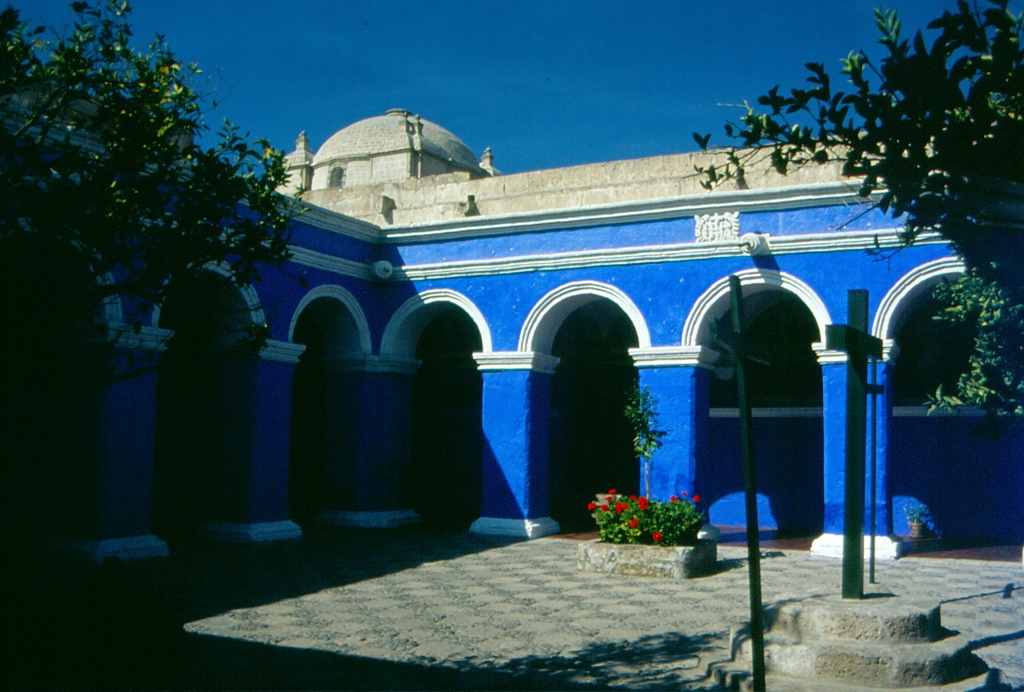 Santa Catalina Monastery, Arequipa
Santa Catalina Monastery, Arequipa
The monastery is rather big and the passages between different buildings have names as if it were a town – Cordoba street, Toledo street, etc. There are a lot of flowers and in one part there are baths like half-amphorae intended for washing clothes. The walls of some yards and buildings are covered in bright paint, while others exhibit only stones. Within the monastery’s ground there is also a section with the cemetery for nuns. The significance of this monastery is corroborated by the fact that the Pope John Paul II declared one of their nuns living in the 17th or the 18th century to be a saint.
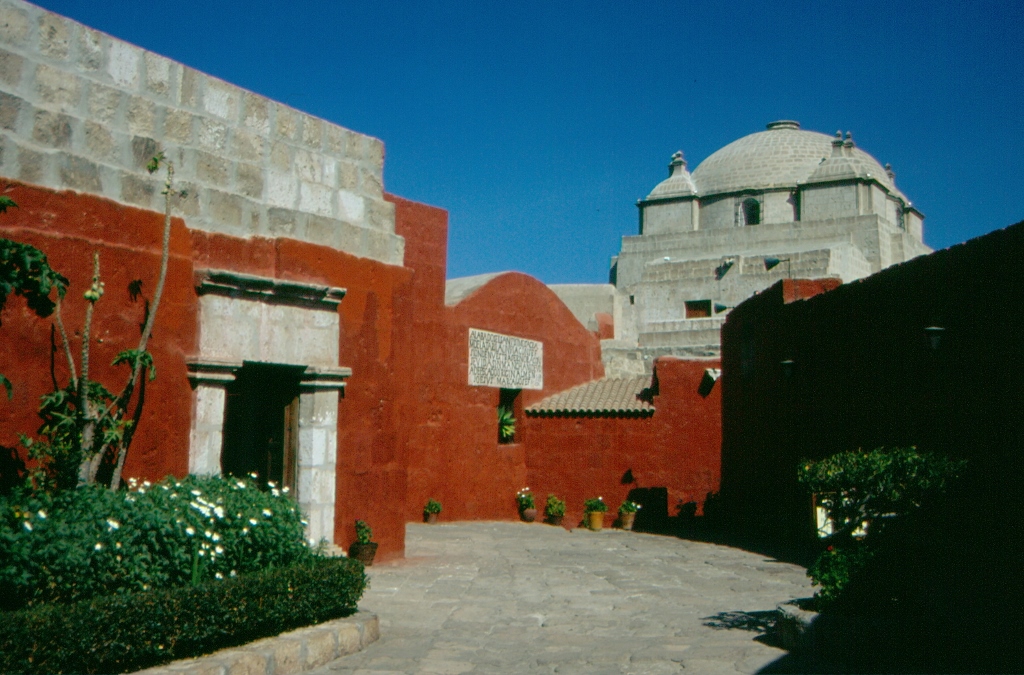 Santa Catalina Monastery, Arequipa
Santa Catalina Monastery, Arequipa
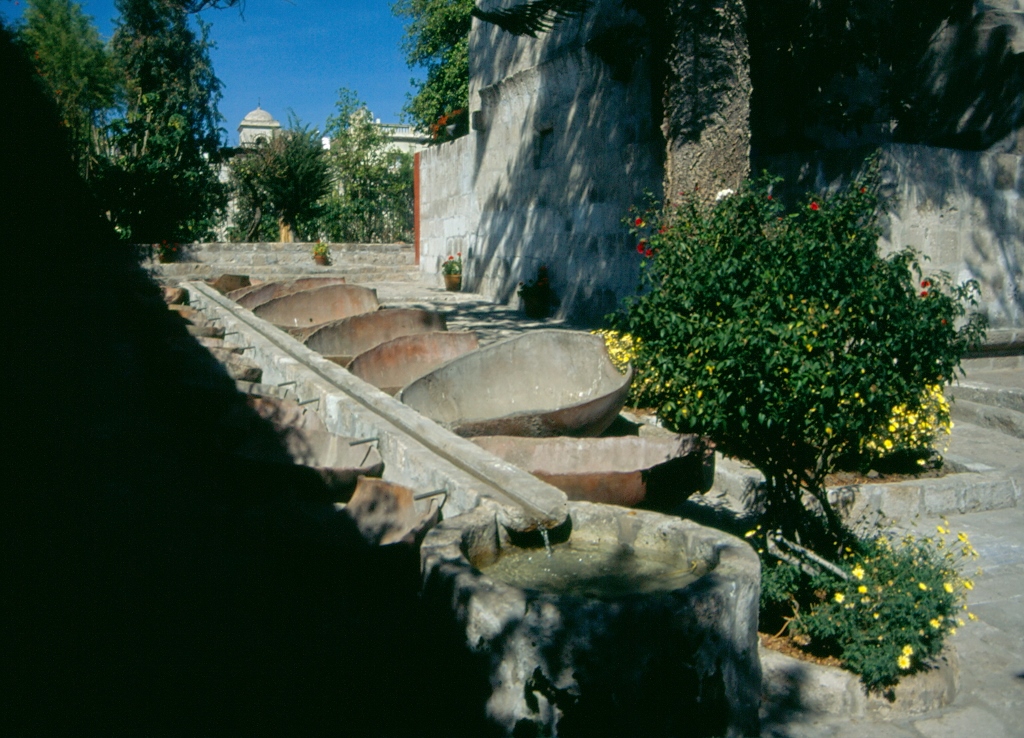 Santa Catalina Monastery, Arequipa
Santa Catalina Monastery, Arequipa
By the way, Arequipa is the second largest city in Peru. It has a couple of million inhabitants, but it leaves a significantly different impression in comparison to Lima – it is dramatically calmer and more laid back. It is reputed to be a wealthy city and this is the place of birth of the Nobel prize winner Mario Vargas Llosa.
After my visit to the monastery, I went to the suburb of Yanahuara where there is a point with the finest view at the volcano El Misti and to a lesser degree at another volcano in the vicinity – Chachani. The most frequently photographed, because of its perfect conical shape that rises above the city, is El Misti. After taking some photos, I walked back to the centre, crossing a bridge over the river San Lazaro and again I could see that the local population loves to “write” messages and mottos in pebbles laid down neatly on lawns, hill slopes, etc.
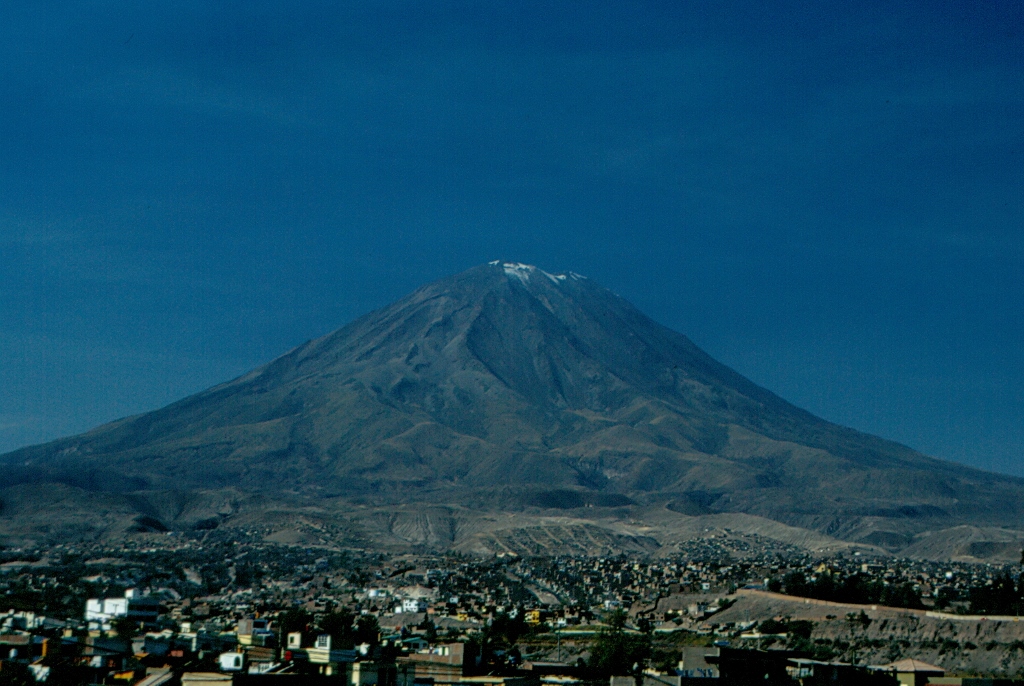 Volcano El Misti, Arequipa
Volcano El Misti, Arequipa
Having returned to the downtown area, I went to the main square, Plaza de Armas, and I sat at a restaurant in order to try a speciality – grilled guinea-pig. The square is surrounded by two-floor buildings, and while galleries (vaulted passages) are on the ground floor, the upper floor terraces that are above these passages are generally taken by restaurants. I went to a restaurant recommended to me by Marlon and from there enjoyed the beautiful view at the Cathedral. While waiting for my dinner to arrive, I had a local beer which is here called “Arequipeña.” Beers are often called after the place of origin – Arequipeña, Cusqueña, etc. This is what makes most of the difference in these beers – the local water used in the production. As for the guinea-pig, there’s not much meat to speak of, but it is very tasty, albeit somewhat too sticky. It must be eaten using one’s fingers, which I generally do not mind, but this time I really had problems wiping the stickiness off in the end. First I thought it tasted like chicken, but on the second thought I decided on very young suckling pig, since the skin is completely like the roasted pig’s skin and the meat would probably taste the same if we ever roasted piglets that are one month old. The bones are tiny and, as I’ve said, there’s not much meat, but it was really tasty.
The square is the place which people go out to, especially in the evening. There is a fountain with an angel in the middle which the local population calls “turututu” because of the trumpet held by the angel.
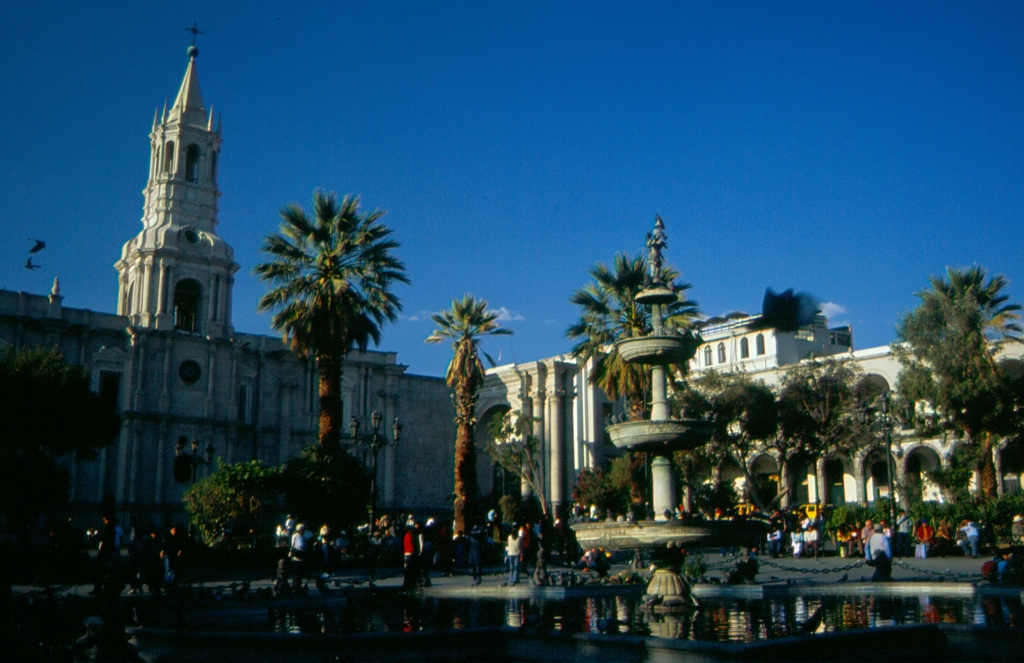 Cathedral and Plaza de Armas, Arequipa
Cathedral and Plaza de Armas, Arequipa
On the way to my hostel, I regularly passed by the church La Compañia with its beautiful stone relief that adorns its front wall.
The next day I went on a two-day trip to the canyon of the Colca river. After breakfast I was picked up in front of the hostel and together with some other people who were already on the mini-bus I was taken to a bigger bus where I found a seat in the back. I didn’t know anybody there, but it soon became apparent that the group was very good and talkative.
The trip took us to the place called Chivay and the Colca canyon. At one point we were passing through a natural reserve that is at around 4000 m a.s.l. and there we saw some vicuñas. This is one of the four species of animals from South America that belong to the same family as camels. In addition to the vicuña, these are also the guanaco, alpaca and llama. Vicuñas and guanacos are wild, while alpacas and llamas are domesticated animals bred by humans. The smallest of them all is the vicuña that renders fantastically soft wool, but only around 250 g per animal and they are protected by the law.
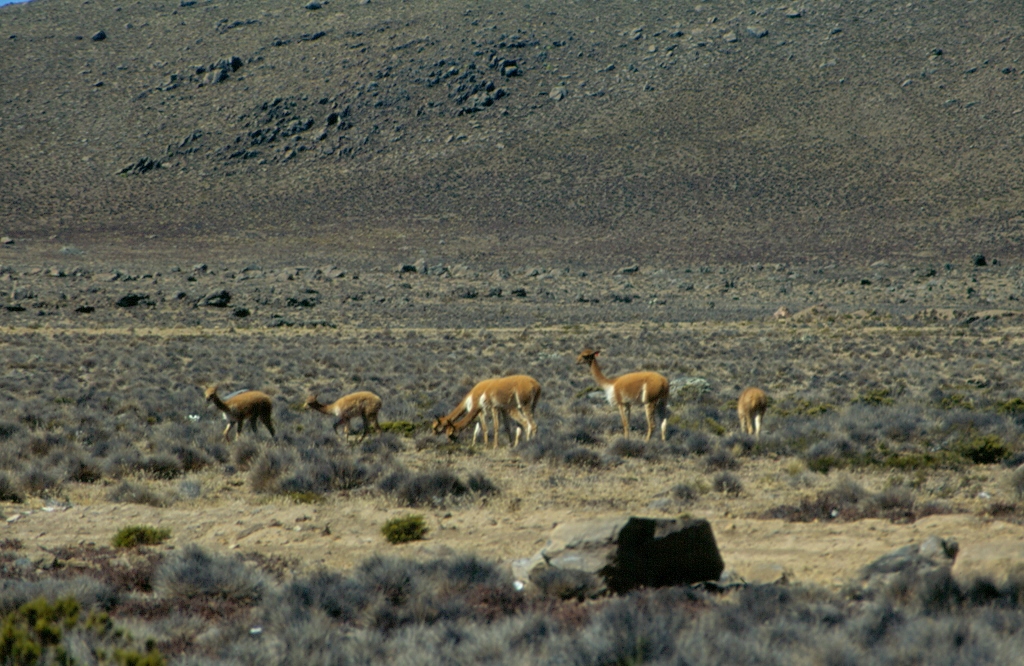 Herd of vicuñas
Herd of vicuñas
The landscapes we passed through appeared rather desolate, but we were told that there is a rainy season in the period December-March and that there is more of a green colour then.
When leaving Arequipa, we first followed the new road to Puno, but after some 80 km we made a turn and since then we practically had no paved or flat road, but rather a lot of shaking and jumping over a dirt road covered by broken stone or some formerly paved road with so many holes that in fact made the dirt road seem much better. This was significantly exacerbated by my seat in the back. And the whole trip took 5 hours from Arequipa to Chivay. On the way there we made a few stops and a slightly longer break at a restaurant with some local women selling traditional crafts nearby, but we could also buy coca candies or take a coca tea at the restaurant.
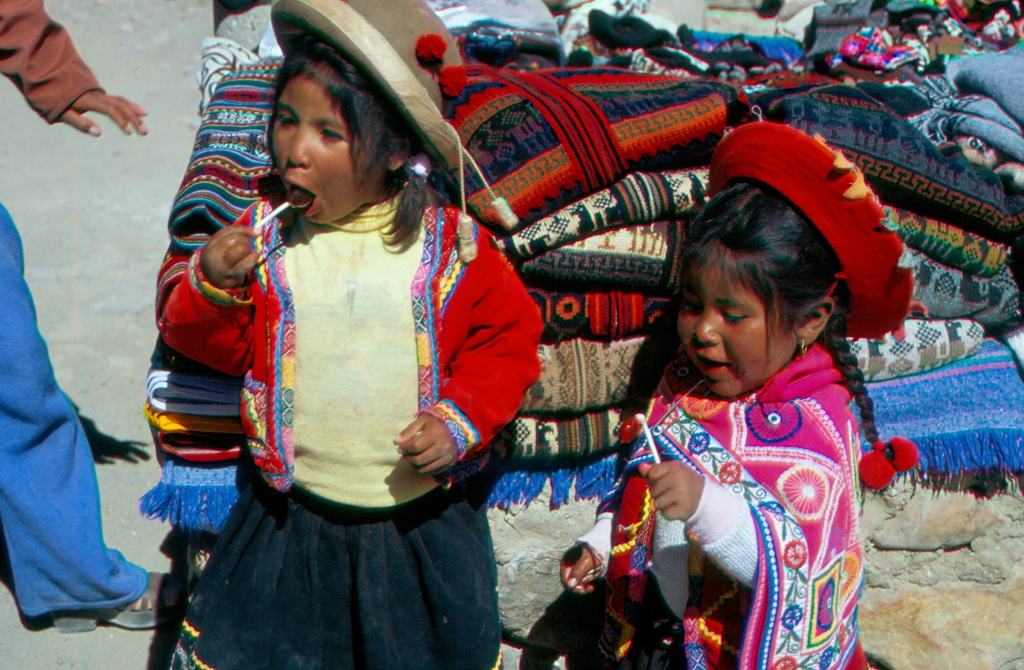 Near a restaurant on the way to Chivay
Near a restaurant on the way to Chivay
In one section the road runs at 4910 m above sea level, but the plan was to make a stop there for taking photos on our way back. Relatively soon after we went down to Chivay (3635 m a.s.l.) – a small place with around 5000 inhabitants that represents a tourist base for visiting the surroundings. There I was placed in a huge room with four beds for me alone and I can still remember some electric-blue covers there. For me it was important, however, that I had a couple of thick blankets, but as it turned out they did not retain too much heat during the night.
After settling there, I went for a walk around the place with my hotel neighbours, an Austrian and a French guy. The walk did me well, but after a while I decided to join a part of the group that wanted to visit some nearby thermal springs and have a dip there. I thought that in the cold that ruled at that altitude there was no way for me to go to an open pool, but I did it anyway when I saw quite a number of fellow tourists who crowded in the water that at 40°C evaporated in what seemed to be minus temperatures of the outside air. I loved the hot water at first, but after a while, quite suddenly and exceptionally fast, as if only putting a hood over my head, I got a terrible headache and started to feel completely unwell. Totally without strength, I barely managed to get out, get to a changing room and put on my dry clothes. Getting to the coach that was but some 20 meters away seemed like a Herculean task. I hardly managed to get in and take the first seat I came across and I remained there until we left for the town. Again with some major efforts I got to my room and there I started to wonder how I would be transported from there. I could already see myself on a stretcher being taken to Arequipa, since I could hardly stand on my feet, that’s how much without any strength I was. Then I started to get sick and I tried to vomit, but I couldn’t. And I absolutely could not fathom what was going on. I still had horrible headache and then I suddenly remembered that usually when I do have a headache, which happened to me 3 or 4 times in my life, I take an aspirin and it passes. I had left my baggage in Arequipa, at Marlon’s hostel, and took with me only the clothes for a day. Fortunately, I was smart enough to take along a small handy “pharmacy” and there I had aspirins. I took two and it started to help. Needless to say, I felt no inclination of going to some tourist event with local folk dances and went to bed at 7 in the evening. I slept relatively well and in the morning I got up at 5.20 fully joyful and fine as if nothing had happened. I presume it was an episode of altitude sickness which was probably prompted by too long a stay at too hot water for me.